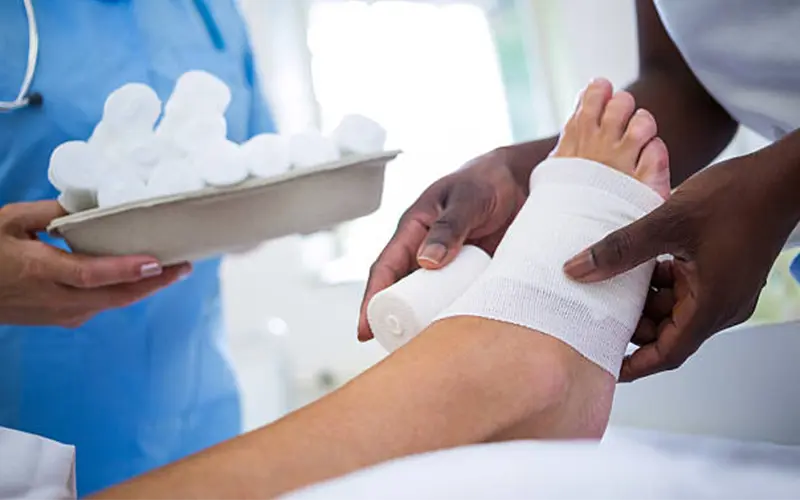Diabetic Foot Care

Care of the diabetic foot and ulcer healing are a complex and often overlooked problem. Upperline Health is proud to offer the latest wound healing agents in the care of diabetic feet.
The last decade has seen an intensive focus on the benefits of proper care for diabetics and for good reason. According to the centers of Disease Control, diabetes mellitus is the seventh leading cause of death in America. It affects about six percent of the population and is more common among minority groups. As more Americans become overweight, the incidence of diabetes has increased. In fact, the prevalence of diabetes has increased six-fold during the last two generations.
Diabetes is a costly disease to patients, their families and to the county. It is estimated that the cost of diabetes care exceeds $1 billion annually. Moreover, the cost in diabetic lower extremity amputations alone exceeds $600 million dollars a year! And a single lower extremity ulcer can cost between $10,000 and $60,000 to treat. Fortunately, much of the physical, mental and financial cost of the disease can be avoided. In a study published in the Annals of Internal Medicine, it was estimated that one half of all lower extremity amputations could be avoided with proper care.
The Do’s
- Wash and carefully dry your feet each day, and use a good quality moisturizer to keep them soft. Dry between toes, but don’t apply lotion.
- Inspect your feet for anything unusual, such as cuts, scrapes, bumps, an odd shape, or discoloration
- Carefully trim nails (straight across and not too short). Use a pumice stone or emery board on any calluses after your shower.
- Keep your feet warm by wearing socks and shoes when it is cold, and wear loose socks in bed
- Choose socks and shoes carefully. They should fit well and not cause pain, hamper your movements, rub against any part of your foot, or have tight elastic tops.
The Don’ts
- Don’t get your feet wet outdoors in the snow or rain, and don’t soak your feet.
- Avoid direct heat from a fireplace or campfire, heating pad, furnace vent, or radiator.
- Don’t use sharp instruments on your feet and avoid abrasive foot care products.
- Don’t use over-the-counter foot treatments containing acid or antiseptic solutions except under a physician’s direction.
- Don’t smoke, as it interferes with normal blood flow.
- Don’t cross your legs while sitting.
- Don’t wear high heels or shoes that pinch your toes, and don’t lace shoes too tightly.
Ulcer Care And Wound Healing
Care of the diabetic foot and ulcer healing are a complex and often overlooked problem. Upperline Health is proud to offer the latest wound healing agents in the care of difficult diabetic feet. Following a rigorous pre-treatment evaluation and testing, wound healing is implemented in our wound care setting. From genetic skin grafts to local wound flaps, there are few wounds that we cannot heal.
Genetic Skin Grafting
Through the powers of genetics, a form of human skin is now available for wound healing. This genetic skin is live tissue that is grown in a laboratory under sterile conditions. The skin has no risk of infection in any way and is used for its growth hormone release into the wound. The Foot and Ankle Institute is proud to be a world leader in the use and implementation of genetic skin in the healing of diabetic foot ulcers.
Charcot Reconstruction
Charcot foot and ankle conditions are often very challenging. Through our years of experience with charcot feet, we have began to rebuild feet destined for amputation. The Ilizarov fixation system allows for manipulation and correction of deformity in the most difficult of charcot feet. Furthermore, in most cases, full weight can be placed on the foot during the healing period.
Limb Salvage
Diabetic patients often do not receive the same level of consideration for limb preservation as a non-diabetic patient. Upperline Health has a wide array of testing equipment and wound healing options for difficult diabetic ailments. From simple wound healing to the most complex charcot foot reconstruction, we will not give up on a possible salvage of your foot and leg until there is no other option. Through our association with diabetic and vascular surgery experts, a complete treatment plan will be implemented in order to allow the greatest chance of limb salvage.
Diabetic Shoe and Insole Program
Due to the increasing number of amputations in the United States, Medicare has implemented a diabetic shoe and insole program. This program allows a diabetic patient who meets certain criteria to receive one pair of shoes and three pairs of insoles per year that are covered by Medicare. The Foot and Ankle Institute is proud to offer this service to patients as part of our complete diabetic prevention program.
Remote Monitoring Socks
Upperline Health has partnered with a remote patient monitoring service to provide a temperature monitoring solution for patients with diabetic or peripheral neuropathy. The Remote Monitoring Socks, which are comfortable, washable, and covered by insurance, monitor temperature at six key points to detect early signs of inflammation, allowing for early intervention and prevention of diabetic foot ulcers. Patients benefit from increased contact with podiatrists as part of a comprehensive diabetic foot health program.

Contact one of our Upperline Health clinics to get your Diabetic Foot Care treatment started.
Treatments offered may vary by clinic.

